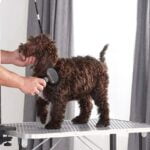Table of Contents
The Old English Sheepdog, known for its distinctive shaggy coat and gentle disposition, is a beloved breed. However, like all breeds, they are prone to certain health issues. Understanding these health concerns for the Old English Sheepdog can help you take proactive steps to ensure your dog’s health and well-being.

1. Hip Dysplasia
Hip dysplasia is a common genetic condition that affects the hip joints:
- Symptoms: Limping, difficulty rising, reluctance to exercise, and pain in the hip area.
- Management: Weight management, joint supplements, anti-inflammatory medications, and surgery in severe cases.
- Prevention: Ensure proper nutrition and avoid excessive exercise during growth periods.
2. Progressive Retinal Atrophy (PRA)
PRA is an inherited condition that leads to gradual vision loss:
- Symptoms: Night blindness, dilated pupils, and difficulty seeing in low light conditions.
- Management: There is no cure for PRA, but managing the condition involves providing a safe environment and regular vet check-ups to monitor progression.
- Prevention: Genetic testing of breeding dogs can help reduce the incidence of PRA.
3. Hypothyroidism
Hypothyroidism is a condition where the thyroid gland is underactive, leading to a slow metabolism:
- Symptoms: Weight gain, lethargy, hair loss, and skin problems.
- Management: Lifelong thyroid hormone replacement therapy, regular blood tests, and a balanced diet.
- Prevention: Regular vet check-ups can help detect hypothyroidism early.
4. Bloat (Gastric Dilatation-Volvulus)
Bloat is a life-threatening condition where the stomach fills with gas and twists:
- Symptoms: Distended abdomen, restlessness, drooling, and attempts to vomit without success.
- Management: Immediate veterinary intervention is crucial; treatment may include stomach decompression, fluid therapy, and surgery.
- Prevention: Feeding smaller, more frequent meals and avoiding vigorous exercise immediately after eating can help reduce the risk.
5. Deafness
Deafness can be a congenital condition in Old English Sheepdogs:
- Symptoms: Lack of response to sound, difficulty waking from sleep, and unresponsive to commands.
- Management: Training with hand signals, maintaining a safe environment, and regular vet check-ups.
- Prevention: Genetic testing of breeding dogs can help reduce the incidence of congenital deafness.
6. Autoimmune Diseases
Old English Sheepdogs can be prone to autoimmune diseases, where the immune system attacks the body’s own tissues:
- Symptoms: Vary depending on the specific disease but can include skin lesions, joint pain, and general malaise.
- Management: Immune-suppressing medications, regular vet check-ups, and supportive care.
- Prevention: Early detection and management are key; regular health screenings can help identify problems early.
7. Heat Sensitivity
Due to their thick coats, Old English Sheepdogs can be sensitive to heat:
- Symptoms: Excessive panting, drooling, lethargy, and signs of heatstroke.
- Management: Provide plenty of water, ensure access to shade, avoid exercise in hot weather, and use cooling mats or fans.
- Prevention: Monitor your dog closely during warm weather and take steps to keep them cool and comfortable.
Conclusion on Health Concerns for the Old English Sheepdog
Understanding the health concerns for the Old English Sheepdog allows you to take proactive steps in managing and preventing these conditions. Regular veterinary check-ups, a balanced diet, proper exercise, and a safe environment are essential for maintaining your dog’s health. By recognizing the symptoms early and seeking timely veterinary care, you can ensure a better quality of life for your beloved pet. For more information on dog health and care, visit the ASPCA and AKC.
FAQs on Health Concerns for the Old English Sheepdog
How can I prevent hip dysplasia in my Old English Sheepdog?
Ensure proper nutrition, avoid excessive exercise during growth periods, and maintain a healthy weight to reduce the risk of hip dysplasia.
What are the signs of progressive retinal atrophy (PRA) in Old English Sheepdogs?
Signs of PRA include night blindness, dilated pupils, and difficulty seeing in low light conditions. Regular vet check-ups can help monitor the condition.
How do I know if my Old English Sheepdog has hypothyroidism?
Symptoms of hypothyroidism include weight gain, lethargy, hair loss, and skin problems. Regular blood tests and veterinary check-ups can help diagnose the condition early.
What should I do if my Old English Sheepdog shows signs of bloat?
If your dog shows signs of bloat, such as a distended abdomen, restlessness, drooling, and attempts to vomit without success, seek immediate veterinary intervention.
How can I manage my Old English Sheepdog’s sensitivity to heat?
Provide plenty of water, ensure access to shade, avoid exercise in hot weather, and use cooling mats or fans to keep your dog cool and comfortable.
What are common autoimmune diseases in Old English Sheepdogs?
Old English Sheepdogs can be prone to autoimmune diseases, which can cause symptoms such as skin lesions, joint pain, and general malaise. Regular health screenings and veterinary check-ups are essential for early detection and management.











